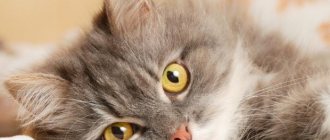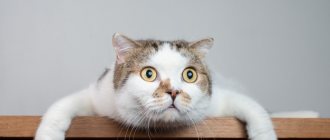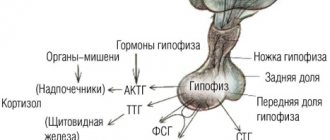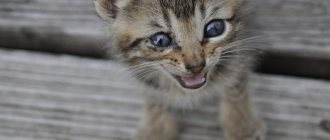Providing competent care for the cat’s oral cavity is an obligatory concern of the owner. Teeth are intended for different purposes - with their help the pet feeds, defends itself and attacks the victim. Various dental problems and the development of dental diseases are a common problem. Therefore, it is very important to take measures as early as possible to prevent health problems, as well as promptly carry out therapy if necessary to avoid complications.
Plaque, tartar, and tooth and gum disease can be prevented. The condition of your pet's teeth and its overall health largely depends on the correct organization of oral care. Correct actions in this direction and regular veterinary examinations are important components of health.
Cat's dental system
Dental diseases at the primary stage of their development are quite difficult to diagnose. However, understanding what the normal structure of a cat’s dental system should be will help you notice the problem in time and immediately begin treatment measures, thereby avoiding complications.
Important! The occurrence of any disorders in the oral cavity may indicate the onset of an inflammatory process caused by infection or the proliferation of pathogenic bacteria.
Baby teeth erupt in newborn kittens a few weeks after they are born. After 6-7 weeks, they begin to give way to permanent ones: this stage is normally virtually invisible, but in some individual cases it can cause significant discomfort to the animal. At this time, the cat’s body produces a special substance - lysozyme, which helps stop the development of infection, providing an antimicrobial effect. An insufficient amount of lysozyme can provoke a disruption of the bacterial background, which will provoke the occurrence of tartar and caries.
A healthy domestic cat normally has 30 teeth - 16 on the upper jaw and 14 on the lower:
- Incisors. Small teeth located in front on both jaws, 6 pieces each. The animal does not use them for chewing food - they serve to fix prey in the mouth or hold large pieces of food.
- Fangs. The longest and sharpest teeth are used by wild animals to kill their prey. The canines are quite powerful because they have the deepest root canals. On the jaws of cats there is one fang on both sides.
- Premolars. Small molars are suitable for grinding food, particularly meat. All cats have six upper and four lower premolars with roots of different lengths.
- Molars. Also designed for grinding food.
The structure of the cat's dental system
What is peritonitis
global $ads_google; //data-ad-slot=”2475549904″ $ads_google = empty($ads_google) ? false : true; ?> if ($ads_google == false) {?>
$ads_google = true; ?> } ?>
In 1963, peritonitis was described for the first time, although the causative agent of the virus itself was identified only in 1977. But in 1981, enteritis or coronavirus was officially registered. It is noteworthy that cats can be infected by some strains of coronavirus that are characteristic of the canine body.
Feline coronaviruses are divided into feline infectious peritonitis virus (FIP) and strains that can only cause minor enteritis or do not pose a serious threat to the health of pets (FIP).
The only difference between both varieties is the ability to harm the cat’s body, but, nevertheless, VPK is a mutated strain of KKVK.
Causes of dental disease in cats
All teeth in cats, like in humans, are theoretically susceptible to mechanical damage, for example, when a tooth breaks due to a head injury or as a result of a strong blow. However, most often, pathologies of the dental system in cats have the following causes:
- Genetic failure. Often, defects in the structure of the oral cavity and an inherent hereditary factor of predisposition to diseases are found in selective breeds of cats.
- Pathologies of bite and enamel. In some breeds, several permanent teeth are missing from birth, which leads to accelerated wear of the remaining teeth and thinning of the enamel.
- Ecology - the influence of chemicals and carcinogens in air, water and food.
- Infections that can cause abscesses leading to tooth loss.
- Lack of oral hygiene. If the owner does not promptly eliminate plaque on his pet’s teeth, its layer is transformed into hard tartar, which can damage the gums and lead to the appearance of even more serious pathologies.
Types of malocclusion
Preventive measures
Wild cats, living in natural conditions, clean their teeth and gums mechanically on their own. They eat raw meat and clean their mouths with grass.
Pets live much longer than their counterparts. With age, teeth wear down and cracks and chips appear. They do not have the ability to clean their teeth on their own. Therefore, only the owner is able to help his pet avoid the unpleasant consequences of diseases of the teeth and gums.
To ensure your cat’s dental health does not cause problems, the following is important:
- — provide a balanced diet, including essential minerals and vitamins;
- - regularly conduct preventive examinations of the oral cavity;
- - ensure thorough care of teeth and gums, removing food debris and plaque using a regular toothbrush and soft cloth;
- - if even minor inflammation occurs, rinse your mouth with special antimicrobial agents;
- - systematically have your animal examined by a specialist: the sooner the problem is identified, the easier it can be dealt with.
Symptoms of toothache in cats
Since there are many causes of dental disease in cats, it is advisable for the owner to closely monitor his pet in order to notice the problem at the initial stage of its development. The most common signs of dental disease in cats are:
- red, sore, or swollen gums;
- the presence of an abscess or lump on the animal’s jaw;
- pungent and unpleasant odor from the mouth;
- loose or worn down teeth;
- increased salivation.
Attention! It is important to remember that the symptoms of dental diseases usually appear gradually, so attentive owners always have a chance to notice the pathology in time and begin treatment, preventing the development of the disease.
At the same time, the animal’s reaction to toothache is practically no different from the human reaction:
- It becomes painful for the animal to chew, especially in the area of the affected tooth. If the pain is very severe, the cat may refuse to eat altogether. You can easily notice that she is trying to chew so as not to touch the sore tooth.
- The cat's behavior changes: it becomes irritated, aggressive, and is capable of scratching or biting its owner, especially when trying to pick it up and examine its mouth.
- The animal constantly rubs its face with its paw, washes itself or persistently rubs its cheek on hard surfaces, meows, and behaves restlessly.
Causes and symptoms of toothache
Prevention and care
To prevent the occurrence of dental pathologies, veterinarians recommend starting to monitor your cat’s oral cavity from an early age. Kittens should eat well; their diet must include complete protein in the form of white meat, cottage cheese, eggs, and dairy products. Specialists at the Zoovet veterinary clinic recommend periodically giving your pet special dietary supplements that replenish the deficiency of useful micro- and macroelements and vitamins.
Don't forget about keeping your mouth clean. To prevent the development of pathologies such as caries, gingivitis, periodontitis, and tartar, it is recommended to brush your pet’s teeth with a special brush and toothpaste 1-2 times a week. The animal removes plaque on its own using roughage. But hard foods should not predominate in the diet, because they injure the gums, which leads to dental diseases.
The most common dental diseases in cats
Diseases of the dental system in cats are extremely diverse, and they can have different causes and clinical presentations. However, all such pathologies lead to significant health problems, so the owner should constantly monitor the oral health of their pet.
Table. Dental diseases in cats
| Disease | Causes | Treatment | Phytotherapy |
| Tartar | Hard plaque on teeth that provokes inflammation after a certain time | Carried out using a painless ultrasonic cleaning procedure | Rinsing the cat's mouth with a solution of baking soda (1 liter of clean boiled water, a few tablespoons of soda and 5-6 drops of iodine solution). Use 2-3 times a day for 5 days |
| Caries | Tooth decay caused by pathological processes in its hard tissues | Under the supervision of a specialist, depending on the severity of the disease and the number of affected teeth | Irrigate the animal's mouth with tincture of sea buckthorn or anise, a strong decoction of chamomile or St. John's wort (1 liter of clean water for 2-3 tablespoons, leave overnight). Repeat the procedure 1-2 times for 3-5 days |
| Periodontitis | Inflammation of tissue at the tooth root | Spraying or rinsing the mouth with antiseptic preparations | Treatment of the mucous membranes of the mouth and teeth with furatsilin or manganese solution (2-3 drops per glass of water). Repeat twice a day for 3 days in a row |
| Osteomyelitis | Inflammation in the gums | A course of antibiotics is prescribed | Rinsing the mouth with a weak solution of potassium permanganate once a day for 3 days |
| Gingivitis | Inflammatory process on the mucous membrane lining the cat's oral cavity | Conducted exclusively under the supervision of a doctor, involves the prescription of medications and procedures | Irrigate your pet's mouth with a decoction of oak bark, mint leaves, raspberries and chamomile flowers (2-3 tablespoons of the mixture per liter of water). Rinse for 3-5 days, 2 times a day. |
Plaque and stones on teeth
Plaque begins to form immediately after the appearance of permanent teeth in cats. First, an invisible film forms on the enamel, then it turns yellow and covers the entire tooth.
Tartar in cats
Tartar is a crystalline, dark-colored salt deposit. It often causes a distinctly strong stench from a cat’s mouth, loosening of fangs and incisors, and the development of other dental diseases.
Reference! Tartar often forms in old, weakened or sick cats, but sometimes dense plaque also occurs in apparently strong pets.
The stone is formed in those areas that are washed more than others by saliva - first on the sides of the incisors and fangs, then on the inner or outer plane of the molars near the gums. A hereditary tendency to the rapid spread of tartar is present in Siamese, Persian and Abyssinian cat breeds. If plaque can be eliminated by a cat on its own, then treatment of stones should only be carried out under the guidance of a specialist. Most often, ultrasonic cleaning is used to remove stones.
Video - How to brush a cat's teeth?
Dental caries
Caries is characterized by decay of the bone tissue of the tooth, after which the tooth enamel is destroyed and voids appear in its cavity. The onset of the disease can be noticed by a change in the color of the gums near one or a pair of teeth. Then, after a certain time, a swelling appears at the level of the lesion, which is clearly visible externally. Without urgent treatment, there is a possibility of developing abscesses and purulent fistulas.
Treatment of caries will be directly related to the form of development of the disease. In veterinary medicine, it is practiced to stop the source of spread with silver nitrate or sodium fluoride. If the caries is advanced, the tooth often needs to be removed.
Periodontitis of teeth
Periodontitis is considered a fairly serious disease that can lead to significant consequences. Most often, it begins after several years of active plaque formation and, without timely treatment, leads to loss of the damaged tooth.
Periodontitis is considered a fairly serious disease that can lead to significant consequences.
Important! Unlike gingivitis, which appears in a cat after two years of life, periodontitis occurs in pets at 4-5 years of age. Without proper treatment, it can cause tooth loss.
The disease is acute, purulent, aseptic or chronic. Typical signs of the development of periodontitis are considered to be:
- looseness of one or two teeth;
- swelling of the gums (with purulent form);
- lack of appetite in the cat;
- foul odor from an animal's mouth.
Treatment of periodontitis involves therapy under the supervision of a specialist. Among the therapeutic agents, “Yoddicerin” is used, which is used to lubricate the gums around the affected tooth.
Osteomyelitis of teeth
Osteomyelitis of teeth in a cat
Odontogenic osteomyelitis is an inflammation that is often a complication in the presence of caries, periodontitis or pulpitis. Due to the presence of infection or caries, a cavity filled with pus can form on the gum. After some time, this cavity bursts, and pus begins to ooze into the oral cavity. In addition, this pathology is often accompanied by the rapid formation of plaque, since due to tooth pain it is very difficult to clean the cat’s mouth. Symptoms of osteomyelitis are:
- redness of the gums;
- compacted swelling at the level of the source of inflammation, clearly visible upon examination;
- development of an abscess in the periosteum area;
- formation of a fistula with pus;
- enlarged lymph nodes.
Treatment of osteomyelitis involves contacting a qualified specialist. Antibiotics are often prescribed taking into account sensitivity determination by bacterial culture, including sulfonamides.
Gingivitis of teeth
Dental gingivitis in cats
Gingivitis is an inflammation of the oral mucosa, which is often accompanied by the appearance of ulcers on the gums. Most often, gingivitis in cats occurs when the oral mucosa is damaged by sharp bones from fish or chicken, as well as during the change of baby teeth. In older cats, it can develop during the spread of caries or with significant deposits of tartar.
Attention! Gingivitis often means the presence of other acute diseases of organs or systems.
Severe symptoms include increased salivation, thirst, and abscess of the oral mucosa. Inflamed gums usually take on a purple, reddish or deep burgundy hue. As the disease progresses, bleeding ulcers often occur.
Treatment of the disease involves taking medications under the supervision of a specialist. Sometimes you will need broad-spectrum antimicrobial drugs (Tetracycline, effective in the early stages, and Metronidazole).
The drug "Metronidazole"
Factors affecting your cat's dental health
The health of the dental system of cats, like any other mammal, directly depends on several factors. These include past or developing infectious diseases, nutrition, and genetic characteristics in certain breeds.
Anomalies in the development of teeth and bite
If your pet has certain pathologies in the formation of teeth or bite, this can provoke the occurrence of typical problems:
- difficulty grinding solid food;
- injuries of the mouth and mucous membrane;
- the formation of abnormalities of the digestive organs.
Among the anomalies with the development of teeth in cats, experts identify incorrect bite structure and congenital or acquired enamel defects. So, if at the stage of formation of permanent incisors the baby teeth are not eliminated, the permanent teeth may take an incorrect position.
Important! During the formation of tooth enamel in cats, past diseases can also provoke the occurrence of defects in the upper layer of the tooth.
Diet
A diet consisting exclusively of soft canned food does not have a cleansing effect on tooth enamel.
Eating certain foods and following a diet plays an exceptional role in preventing the occurrence of dental diseases in domestic cats. It is important to remember that a diet consisting exclusively of soft canned food does not have a cleansing effect on tooth enamel and can contribute to the rapid formation of plaque. Moreover, this eating pattern encourages food particles to accumulate in the spaces between food pieces on or between teeth, allowing bacteria to spread and plaque to form quickly.
Dry food, on the contrary, due to the need for thorough chewing, has good cleansing properties. In this case, it is necessary to take into account the composition of such canned food, which should include all the necessary minerals, vitamins and nutrients.
Treatment of dental diseases
Often, the owner’s quick response and urgent contact with a qualified doctor contributes to the most optimistic prognosis for the treatment of most dental diseases in pets. If you delay and ignore the problem, there is a significant likelihood of aggravating it, which can cause sepsis to spread to internal organs, blood poisoning, and in rare cases lead to death.
If you suspect a disease, you should immediately consult a doctor
It should be remembered that there is no single method for treating such diseases in animals, as in humans. Therapeutic measures will depend not only on the nature of the pathology that has arisen, but also on the specific causes of its occurrence, as well as symptoms. The specialist is always obliged to take into account all the circumstances of the manifestation of the disease - only after that can he prescribe procedures and recommend medications.
The owner should prepare for the fact that dental disease in his pet often requires drastic measures - removal of the affected tooth, and in some cases, the teeth located near it.
Forms of feline peritonitis
Not all owners of purring dogs are familiar with this disease; for many, it is just something like a horror story from a series of veterinary fairy tales. But, unfortunately, Feline Infectious Peritonitis, or FIP, is an insidious and real thing.
Cases of infection are gradually becoming more frequent, which is facilitated by the lack of control in breeding, if a stud cat and, at the same time, a carrier of the disease has many matings with meowing representatives of different catteries.
When faced with a disease for the first time, not everyone understands what exactly they are faced with; even a visit to the veterinarian does not always immediately clarify the picture.
The biological reasons for the degeneration of the insidious feline enteritis virus into the cruel pathogenic coronavirus of peritonitis have not been fully disclosed.
Viral peritonitis has two forms:
- dry;
- wet.
Wet form dry FIP
In weakened cats, the “wet” form is common, with the course of the disease ranging from a couple of weeks to several months. But this does not mean that the infection entered the pet’s body literally the day before: the period from the infection entering the body to the manifestation of the disease can last months or even years.
The wet form has a peculiarity: the body cavities, abdominal, thoracic, pericardial, near the scrotum, begin to fill with free liquid with a bright yellow color, viscous in consistency.
global $ads_google; //data-ad-slot=”2475549904″ $ads_google = empty($ads_google) ? false : true; ?> if ($ads_google == false) {?>
$ads_google = true; ?> } ?>
Externally, a swollen belly gradually becomes noticeable, with the pet’s overall weight loss. The ridge protrudes, the muzzle becomes haggard. The skin loses moisture, the skin changes color, becoming yellowish.
Late stages of wet FIP are characterized by an impressive-looking abdomen.
Non-infectious peritonitis
There is a concept of non-infectious peritonitis: this is a consequence of perforation of internal organs and the spilling of their contents into other cavities of the body, which causes suppuration with all the serious consequences. This type of peritonitis is resolved by surgery and is in no way associated with coronavirus.
Dry form wet FIP
global $ads_google; //data-ad-slot=”2475549904″ $ads_google = empty($ads_google) ? false : true; ?> if ($ads_google == false) {?>
$ads_google = true; ?> } ?>
In the dry variety, the symptoms are not so noticeable, although the nervous system suffers more. The body is affected in different tissues, which affects the manifestation of signs of the disease. Such affected lesions are called granulomas.
The body, in both wet and dry forms, steadily fades away, and the animal faces death.










